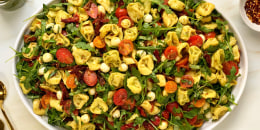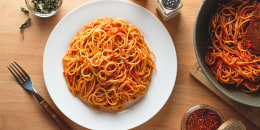Much of the food we eat has been processed in some fashion, and the latest data suggests that nearly 60% of the food we eat is considered heavily processed.
From a jar of pasta sauce to whole-grain bread to frozen entrees and chicken nuggets, processed foods make it easier to put a meal together. Food processing has plenty of advantages, but ultraprocessed foods may increase your risk of health problems. Read on to learn about the health impact of processed foods, how to identify them, and some healthy (and unhealthy) processed foods.
What are processed foods?
Anything that’s been frozen, canned, cooked, dried, or packaged is considered processed — at least to some degree. Those frozen blueberries you add to your smoothies? Processed (though minimally). The canned beans you add to tacos? Also processed. Old-fashioned oats? Yup, those have been processed, too. As you can see, plenty of healthy foods are considered processed.
Food may be processed to prevent spoilage so it stays safe to eat for a longer period of time. It might also be processed to make it more convenient — thank goodness for bagged salad greens! Sometimes, food is processed to enhance its flavor or texture, such as plant-based coffee creamers. Certain foods are processed to make them more nutritious by adding vitamins and minerals. This is the case with refined grains and sugary cereals (though they’ve also gone through additional processing). Food may also be processed to make it safer to eat. However, despite these advantages, there can be disadvantages to food processing.
Processed vs. ultraprocessed foods
Most of the headline-making research on ultraprocessed foods has used a classification system called NOVA from the University of Sao Paulo in Brazil. Foods fall into one of four categories:
- Unprocessed or minimally processed foods include fruits and veggies (and their prepped or frozen versions), eggs, milk, plain yogurt, and natural meat, poultry and seafood. You can also find grains like flour, rice and pasta under this category.
- Processed culinary ingredients are used to enhance unprocessed or minimally processed foods. Think salt, sugar, oil, vinegar and honey.
- Processed foods are made from combining ingredients in the first two categories. So, anything from canned tuna and beans to cheese is considered processed.
- Ultrprocessed foods are made with ingredients you don’t find in a home or restaurant kitchen, such as additives, preservatives, colors and emulsifiers. According to the classification system, this group includes anything from soda to sweetened yogurt to processed meats, chips and many other foods on grocery store shelves. These foods are designed to be extra convenient and extra tasty, making them easy to eat — or overeat.
It’s worth mentioning that this system is a research tool, but it may not be the most helpful way to decipher the healthfulness of the foods you eat. That’s because some foods that are classified as ultraprocessed — such as whole-grain, packaged breads — are much healthier than others, such as soda.
On the other hand, some foods, such as white rice, have been processed to remove the fibrous and nutrient-rich germ and bran, but they are considered minimally processed by this classification system.
How to identify processed foods
Some foods are undeniably processed, like bacon and beef jerky. It gets a little murkier with healthier foods, such as low-sugar yogurt and whole-grain breads and cereals. These foods, while processed, have valuable nutrients from their whole-food ingredients, such as calcium and protein in yogurt, and fiber and antioxidants in whole-grain breads and cereals.
Rather than getting caught up in the NOVA classification, look at the ingredients to see if there are items you wouldn’t find in your kitchen, like preservatives, colors, flavors and emulsifying ingredients, which all signal a food has been heavily processed. Here are some ingredients to keep an eye out for:
- High fructose corn syrup
- Fruit juice concentrate
- Soy protein isolate
- Whey protein
- Maltodextrin
- Xanthan gum
- Soy lecithin
- Carrageenan
- Caramel color
- Stevia, aspartame, sucralose, and other zero and low-calorie sweeteners
This is by no means a comprehensive list, but it gives you a sense of the types of ingredients to watch out for. It’s also helpful to look at the nutrition facts panel to see how much added sugar, sodium and saturated fat are in the product. Too much of any of these substances can be a sign of heavy processing.
Health risks of processed foods
Evidence is steadily accumulating that eating more heavily processed foods is associated with numerous health issues — 32 different conditions, according to one review. The study found that eating a diet high in these foods was associated with a higher risk of:
- Anxiety, depression and other common mental health problems
- Type 2 diabetes
- Obesity
- Sleep problems
- Dying earlier in life from heart disease or any cause
Other studies have found an association between ultraprocessed foods and a higher risk of cancer and weight gain.
However, these studies don’t prove cause and effect, meaning it’s not been demonstrated that ultraprocessed foods cause these problems. Scientists have consistently found a link between people who eat a lot of ultraprocessed foods and serious health issues.
We’re still uncovering why these foods are so problematic. Is it because they wreak havoc on your gut health? Is it the additives they contain? Is it that they encourage you to overeat? Time will tell, but there’s no need to wait for the science to come in. For now, experts agree that limiting your consumption of these foods and favoring whole or less-processed foods are healthy habits.
Can processed food be healthy?
While it's best to limit heavily processed foods, other processed foods can be a part of a healthy diet.
Focus on processed foods closest to their natural state, with limited amounts of added sugar, salt and additives. These include foods like roasted nuts, canned beans, protein pastas made with a single ingredient (such as chickpea or edamame flour), nuts and nut butters, canned tuna and other canned fish, and fruits and vegetables — whether dried, canned, or frozen with no or little added sugar or seasonings.
Also, keep in mind that it’s what you eat most of the time that has the greatest impact on your health. So, for the most part, focus on filling your plate with whole and minimally processed foods. Try making half your plate a non-starchy veggie at lunch and dinner, and include fruit at breakfast and with snacks. Reserve a quarter of your plate for a whole, starchy carb, such as sweet potatoes or brown rice, and the other quarter for a protein, such as chicken, shrimp or tofu.
Examples of processed foods
While no food is completely off limits, experts agree that eating less of these processed foods is a smart idea:
- Processed meats. This includes both red processed meats, such as bacon and ham, and white processed meats, such as deli or packaged turkey and chicken. Choose another convenient protein, such as store-bought rotisserie chicken, store-roasted fresh turkey, boiled eggs or canned tuna.
- Soda and other sweetened beverages. These drinks are the leading source of added sugars in our diets. While many people replace sweetened drinks with their zero-sugar, unsweetened counterparts, water or unsweetened seltzer are healthier options. If that sounds boring, add a splash of 100% fruit juice, mashed fruit or herbs. Unsweetened herbal tea is another option.
- Refined grains. Even though important nutrients are added back to refined grains, it’s healthier to choose whole grains. There are many quick-cooking options, such as frozen or parboiled quinoa and wild and brown rice. Though processed, whole-grain breads and cereals are healthier than their refined counterparts. When buying cereal, look for varieties with no or little added sugar.
- Chips and other heavily processed crunchy snacks. Try replacing potato chips, pretzels and other munchy snack foods with packaged snacks made with whole-food ingredients, such as roasted nuts and chickpeas.
- Dessert foods. It's more than OK to have dessert sometimes, but for everyday indulgences, try finding healthier ways to satisfy your sweet tooth and curb cravings. Some ideas include store-bought chocolate-covered bananas or banana slices, dates stuffed with nut butter and mini chocolate chips, or a faux crumble made with warmed frozen fruit and low-sugar granola.
Other examples of processed foods that are healthy to keep in your diet on a regular basis include:
- Canned beans
- Canned fish
- Frozen fruits and veggies
- Old-fashioned oats
- Bagged salad greens
- Cheese
- Whole-grain breads
- Whole-grain cereals
- Low-sugar yogurt
Bottom line
Heavily processed foods make life easy, but they may come with certain health risks, so it’s a good idea to reduce your reliance on them. Instead, choose less processed, healthy foods that offer convenience while still being mindful of nutrition.




